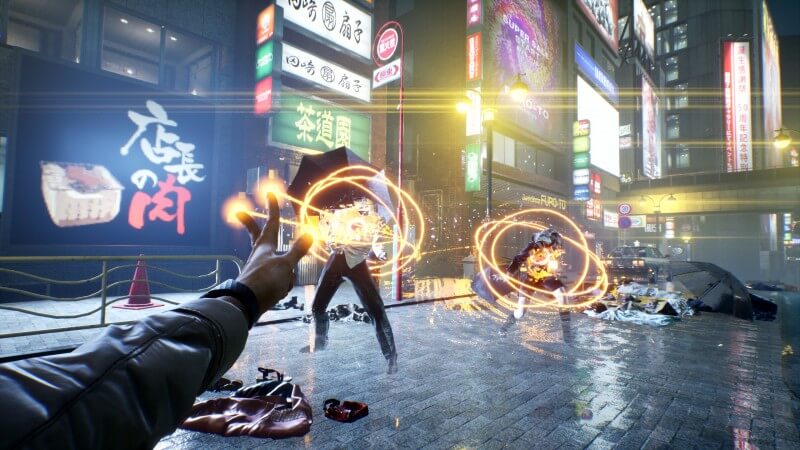Tango Gameworks’ The Evil Within and its sequel are quintessential Shinji Mikami games, unabashedly following in the footsteps of Resident Evil 4 by blending survival horror and action with an over-the-shoulder perspective. However, the studio was never intended to be an avenue for Mikami’s creative vision. Tango was established to showcase talented new young creators, and Ghostwire: Tokyo is the first game to demonstrate this aspiration truly. Nothing else can compare to its quirky brand of open-world exploration and supernatural combat, as it borrows familiar elements and mixes them with new ideas in imaginative and surprising ways. You can stumble at times, but the sheer creativity and attention to detail on display throughout constantly shines through.
Ghostwire: Tokyo storyline
The story of Ghostwire: Tokyo begins at a breakneck pace with one of its protagonists dead on the ground. After being involved in a fatal car accident at Tokyo’s famous Shibuya Scramble Crossing, Akito Izuki is resurrected when a shadowy spirit called KK merges with his body. The unholy union between the pair gives Akito access to KK’s supernatural powers. Still, before he can figure out what is going on, the rest of Tokyo’s residents are engulfed in a nasty fog covering the entire city. A collection of evil spirits known as Visitors now roam the streets of Shibuya in his place, so it’s up to Akito and KK to stop the masked villain responsible before the situation gets any worse.
Both protagonists have different motivations for embarking on this dangerous quest beyond their responsibility to save the world. KK seeks revenge while Akito is desperate to save her younger sister after the villain kidnaps her for nefarious purposes. The connection between Akito and KK is the most vital aspect of Ghostwire: Tokyo’s narrative, as their budding relationship takes center stage and develops naturally throughout the game. Random banter between the pair adds fun to what is often a grim subject matter, and it’s easy to get drawn into their situation even when the mysteries surrounding KK’s past are ultimately unsatisfying.

The rest of the cast doesn’t get enough screen time to stand out or cultivate any attachment, so attempts at emotional payoff are stunted. Akito’s sister Mari is a prime example of this, as she is more of a plot device than an actual character. The villain is also very underused. His motives make him potentially likable, but instead, he’s one-note and ultimately forgettable.
The story’s shortcomings are disappointing considering the initial potential of its compelling mysteries of it. Still, even this is not enough to detract from Ghostwire: the fantastic combat, setting, and construction of the world of Tokyo. When KK intertwined with her body, Akito gained access to supernatural powers known as Ethereal Weaving, granting him the ability to unleash projectiles from his fingertips. Ghostwriter: Tokyo Gives Up Physical Firearms; instead, Akito constantly contorts his hands and performs the finger gymnastics necessary to conjure spectral powers.
You start the game with access to Wind Weaving, allowing you to hurl neon blasts at the invading spirits of Tokyo, but by the end of the second chapter, you’ll also be adding Fire and Water Weaving to your repertoire. The former unleashes a destructive missile that deals heavy damage, while the latter’s horizontal burst and widespread make it an obvious shotgun analog. Each finger flick discharges these colliding projectiles with palpable ferocity, sending vibrating particles scattering into the night sky.
Combat takes a while to find its stride and feels stilted for the game’s first couple of hours, mainly because the fire rate of Wind Weaving is painstakingly slow. However, once you start delving into Akito’s skill tree, this gradually changes. Increasing the rate of fire does wonder to the sense of impact and satisfaction that comes from rapidly blasting enemies away, and the combat’s dynamism only continues to grow once you unlock more powers. You’ll start utilizing Water Weaving in close-quarters to pulverize multiple enemies at once, propel Fire Weaving’s flaming area-of-effect attack to damage some of the game’s most formidable foes, and throw magic Talismans to lock Visitors in place.
A significant reason why combat feels so gratifying is because of the way enemies react to your attacks. You might be fighting apparitions that have some basis in Japanese folklore, but you’re constantly ripping off these digital chunks to reach the inner core festering below the surface. All enemy designs feel like a reflection of Tokyo and its people, meshing modernity with the past. Just as towering skyscrapers cast shadows over traditional Shinto shrines, these evil spirits also emerge from contemporary issues. The faceless, umbrella-wielding Visitors are born from the hearts of those pushed to exhaustion by their work. At the same time, the headless spirits scurrying around the city in school uniforms are derived from students’ anxieties.

Ghostwrie: Tokyo Gameplay
Ghostwrie: Tokyo isn’t a terrifying game, despite these descriptions, yet the atmosphere it conjures is unmistakably eerie. An empty city will always be inherently scary, but that’s especially true of one as populated and dense as Tokyo. This isn’t your typical post-apocalyptic metropolis either, as Shibuya’s residents have only recently vanished. There are still signs of life everywhere you look, with music emanating from the innards of karaoke bars; LED billboards illuminating the rain-soaked urban sprawl; convenience stores welcoming your patronage with a merry jingle and shelves stacked with freshly wrapped onigiri; and discarded clothes, shoes, umbrellas, and phones strewn across the floor, left behind by those consumed in the fog.
One glance at the map is enough to incur the dread of open-world fatigue, yet most of the myriad icons represent shops you can visit to purchase healing items. Exploration never feels overwhelming, mainly because you gain access to city sections in bite-sized chunks. By cleansing corrupted Torii gates throughout Shibuya, you’ll gradually disperse the harmful fog and reveal new side missions and collectibles. These optional quests are concise vignettes that usually revolve around helping spirits trapped in a state of limbo. This might include recovering cursed objects that were sold by a secondhand shop, searching an otherwise quiet neighborhood for the source of ominous piano music, or investigating a construction site where a rash of mysterious deaths has occurred.
You can typically complete these side missions in a few minutes, and their quality fluctuates wildly from one to the next. At their best, you’ll unravel a compelling paranormal mystery that mixes combat and exploration; at their worst, you’ll be thrown into a bland arena battle or have to tail a yokai for what feels like an eternity. These side missions are never outright wrong, and they typically shed light on a particular facet of Japanese folklore, but too many of them lack depth and feel like they were included to pad out the open-world activities.
Ghostwire is obsessed with urban isolation that even in a city where millions of people live on top of each other, you can feel lonely. Ghostwire achieves this feeling by taking people in completely. Walking through a city without its population has an eerie quality, knowing there’s no one to talk to beyond yourself and the (literal, in this case) voice in your head. Most of the time, I found myself wishing there were people, or even just one friendly person, that I could find on the streets of Ghostwire. Not because I was ever bored walking through an empty world, but because its sense of isolation and loneliness was efficient and unsettling.
And I mean disturbing. Ghostwire takes every opportunity it gets to sell its spiritual apocalypse. From time to time, the game messes with you. Walking, I saw the lines painted on the street rippling in the wind like thin pieces of paper. Or I’d turn a corner and realize that perhaps in an alley or small city block, the rain was now blood, drenching the surrounding buildings and the street a dark, muddy red. More dramatically, in critical elements of the story, the world shatters around you. In fantastic stage moments, levels seamlessly twist, warp and shift before your eyes, as if M.C. Escher has taken over as art director. It’s endlessly impressive and fun to watch, and I loved using the photo mode to capture the weirdness around me.
Recalling classic images of ecstasy, personal belongings litter the map exactly where they left them: he can’t take his bag or cell phone to the afterlife. The most surprising thing is that clothes are everywhere. Especially in high population areas, large seas of garments often litter the floor where people disappear. It’s images like this that highlight the ecstatic scale of the game and how terrifying something like this would be. Add in that the city is still going:
- The lights are on.
- The speaker systems are blaring.
- You can go to the subway or inside the convenience stores.
- Ghostwire has a world that isn’t hampered by a lack of things to do but empowered by your commitment to be desolate.
Reuniting this world with the next leaves Shibuya overrun with spirits. The vast majority of Ghostwire runs from point A to point B, fighting off a variety of hostile yōkai that litter the streets along the way, reaching their destination and then fighting some more. There’s a solid heft and crunch to combat that’s satisfying from an audio and visual perspective. All of Akito’s elemental powers also have their unique perks. I enjoyed switching between my fire attack, which launches a high-damage blast, and my water attack, which sends out a wide arc that hits multiple enemies. Other fun powers, like a wind attack with a high rate of fire, magical bow and arrows, and talismans that freeze enemies, are fun to experiment with. And using ethereal weave, which is a magical rope, to rip out enemy cores always looked fabulous.
Although it has no weapons, Ghostwire effectively plays like a first-person shooter. But not very good. Aiming is often clumsy and inaccurate, and I missed more attacks than not. The layout of the encounter rarely changes from: there are a handful of enemies surrounding this point of interest. Kill them, move on. It’s not necessarily bad as it gets the job done, but combat quickly gets repetitive. The game’s handful of bosses fares no better, often feeling awkward and slow to fight.
However, not all spirits want to kill you. When you’re not making your way through Shibuya, you’re gathering spirits trapped between the two worlds. There are over 240,000 lost souls you need to help return to the death spiral, which means spending a lot of time walking around collecting, which boils down to pressing a button or, very rarely, solving a little puzzle and depositing at various public telephones, on the entire map. Fortunately, you collect spirits en masse, so you don’t have to collect all 240,000 individually, but it’s still a tedious side goal.
Which makes Ghostwire an odd game to review, at least within the often restrictive confines of a scoring system. The things that I like about Ghostwire, I like. I’d go so far as to say that some elements (your world, enemy design, etc.) are among my favorites in a game in years. That said, there are a lot of elements, like story and gameplay, where GhostWire barely falls short.
I hope some people don’t fall in love with the game as I did, and I think that’s completely understandable if you don’t want to forgive the game for that. But if Ghostwire connects with you, I think it will connect with you. It’s weird and unique, and I think it’s great to see this kind of game get this kind of budget, put it all on the table, and use that money to make some amazing puzzling art. And for that alone, I can’t help but love Ghostwire.





